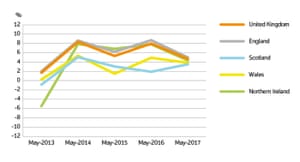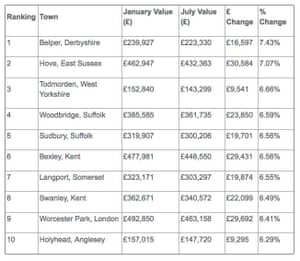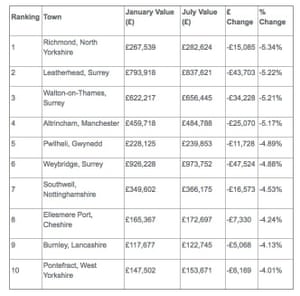Growth in UK house prices has slowed but remains close to 5%, with faster growth seen outside London, according to official data.
House prices across the country increased 4.7% in the year to May, hitting an average of £220,713, the Office for National Statistics (ONS) said. The annual rate is down from 5.3% in April. Between April and May, prices were up 0.5%.
House values rose in all regions, with the east of England still growing at the highest annual rate, of 7.5%, followed by the east Midlands at 7.2%.
Analysts at Jefferies said: “Despite the election and consistent doom-mongering, we note that house prices continue to increase.”
The north-east registered the slowest annual growth, of 1.6%, followed by London at 3%. Prices in the capital are still more than twice as high as the UK average, at £481,345.
The most expensive borough to live in was Kensington and Chelsea, in west London, where the average property cost £1.5m, up 17% in the year to May. In Burnley, Lancashire, the average house cost £78,000.
James Allen, head of alternative investments at financial services firm Walker Crips, said: “It is clear that prime London may as well be a different country.” He added that buyers in Kensington and Chelsea would need a deposit of £450,000, based on a mortgage at 70% loan to value.
“For a one-salary household, gross income would have to be £222,000. The number of people in the UK earning more than £200,000 is estimated to be 235,000 or 0.7%. When such a small proportion of the population can afford to live in a borough, demand must be coming from other quarters, namely foreign buyers.”

The ONS uses data from the Land Registry. Its annual house price growth has slowed since mid-2016 but remains faster than the 2-3% growth reported by major mortgage lenders Halifax and Nationwide in recent months. Analysts believe that a fresh slowdown is under way, with Hansen Lu at Capital Economics pointing to a sharp fall in new buyer enquiries reported by chartered surveyors in May.
Samuel Tombs of consultancy Pantheon Macroeconomics is predicting that year-on-year growth will slow to 1.5% by the end of the year.
Tombs argued: “Lenders are reporting that they will lend less in the third quarter and the recent pickup in wholesale funding costs suggests that they will not continue to cut mortgage rates. Meanwhile, the recent deterioration in consumer confidence, largely in response to the intensifying squeeze on real incomes, has made households less willing to make big ticket purchases.”
The number of homes sold in the UK slumped 41% year-on-year in March, largely because March 2016 recorded an unusually high level of transactions as buyers rushed to complete before stamp duty and tax changes the following month, the ONS said. In London, transactions fell even further, by 57% (and 62% in inner London).
The housing slowdown means that the average home in Britain has increased just over £3,000 in value (or £16.79 a day) since the start of the year, according to analysis by property Zoopla. The website found the typical home was valued at £304,469 as of 30 June, £3,309 more than in January. By contrast, the average property value increased by £13,852 in the same period last year.
Belper in Derbyshire, Hove in East Sussex, Todmorden in West Yorkshire, Woodbridge and Sudbury in Suffolk are property hotspots, according to Zoopla, with the fastest house price growth since January. Richmond in North Yorkshire, Leatherhead and Walton-on-Thames in Surrey, and Altrincham in Manchester were identified as coldspots, with the biggest percentage falls in values of around 5%.

Doug Crawford, chief executive of conveyancing website My Home Move, said that despite the slight slowdown, “the housing market is still simmering away nicely. Even though the overall growth rate has fallen, for first time buyers the slower rate of house price growth will be welcome, particularly with inflation running ahead of wages for many.”
However, recent research by his firm found that average deposits climbed £6,000 in the last year, with increases in some regions of more than 30%.
Anne Baxendale of housing charity Shelter said: “While prices may be slowing in London, the idea of owning a home of your own is still just a fantasy for most people.
“The government needs to change the rules of the game by introducing a fresh, new way of building homes which brings down the colossal cost of land and gives more powers to communities to deliver the genuinely affordable, high-quality homes that ordinary families are crying out for.”
Rents are also going up. Private rents rose 1.8% in the year to June, the same rate as in the previous three months, according to an experimental rental housing index from the ONS. It shows rents rose 14.8% between January 2011 and June 2017, driven by London.

